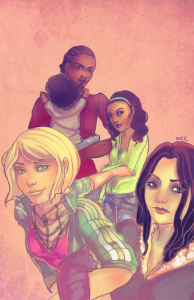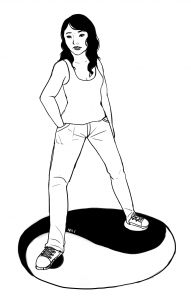Neither Here or There: The Mixed-Race Experience
 When my cousin was very young, my aunt would take her for walks in her stroller. Her hair was very difficult to manage, so my aunt would use colorful plastic barrettes to make a dozen poofy ponytails jut out of my cousin’s head. As they walked, some people stopped to say hello or mention how cute she looked. Others came up to ask my aunt, “Why are you dressing that child like a black girl?” or “Why do you have that white baby in ‘afro-puff’?” If she managed to respond, all my aunt could say was, “Excuse me?”
When my cousin was very young, my aunt would take her for walks in her stroller. Her hair was very difficult to manage, so my aunt would use colorful plastic barrettes to make a dozen poofy ponytails jut out of my cousin’s head. As they walked, some people stopped to say hello or mention how cute she looked. Others came up to ask my aunt, “Why are you dressing that child like a black girl?” or “Why do you have that white baby in ‘afro-puff’?” If she managed to respond, all my aunt could say was, “Excuse me?”
My cousin is biracial—her mother is white, and her father is African-American. She looks nothing like me, her pale, blond half-cousin, but she’s distinct from her half-siblings from her father’s family as well. In a society that loves clear labels—straight, gay, black, white—she exists outside of them.
Thankfully, she’s neither alone, nor ignored. More and more multiracial people are entering the public eye, with President Barack Obama, of course, as the most famous. Actress Halle Berry and singer Shakira, among many other American celebrities, are also known for their mixed heritage. But the increased attention to multiracial issues is, unfortunately, a double-edged sword. Many people fetishize mixed-race individuals or envy couples with mixed-race babies. With the entrance of racially ambiguous people into the spotlight, American society has created new labels—“biracial,” “multiracial,” “mixed-race,” and, specifically for those with Asian heritage, “hapa.” These labels, however, are another faulty method of grouping individuals, as no two multiracial people have the same experience.
“I was much more exposed to one parent than the other,” Marissa*, a Scripps sophomore, said. Race did not impact her self-identity until she grew older. “Whenever I am asked about my other side I don’t really have a lot of good answers.” Scripps senior Emi Sawada, who has Italian-American and Japanese roots, has spent time living in all three countries but identifies most strongly with her Asian-American heritage. Her brother feels differently, she said, identifying more as Italian-American.
Both students acknowledged that there are huge misconceptions about multiracial people as a whole, such as them having more insight into “their” cultures, being more beautiful or intelligent, or having “an easier life.” Marissa mentioned that many people assumed she spoke the languages of both of her parents’ home countries, something actress Jessica Alba, who doesn’t speak Spanish, has also mentioned hinders her ability to receive roles written for Latinas. While she lived in Japan, locals saw Emi as wholly American despite her fluent Japanese. She attributed this to her appearance and, in particular, her atypical curly hair. It wasn’t the only time she had to “prove” her race to others—while attempting to go to a party at an Asian-American sorority, the bouncer mistook her for white and denied her entrance. When she spoke with me, Emi radiated confidence about her own self-image and identity, even though it confounded those around her. Her most common pick-up line is, “What’s your ethnicity?”
Because of their appearance and ambiguity, Multiracial children often feel isolated from others. When my cousin began attending elementary school, other African-American girls wouldn’t speak to her—she “dressed too white,” they explained. Marissa, who lives in a mostly white community, said that “for the longest time I wished I was more white-looking,” particularly in comparison with her fairer sisters. She feels more comfortable surrounded by people who share her heritage. Although Emi identifies herself firmly, she still feels conflicted about what cultural aesthetic to align to—Americans prefer lean, curvy physiques and the clothing that emphasizes them, while Japanese fashion has a “balloon-like” style that oftentimes hides the body. Emi added that she “seek[s] out” other Asian Americans because she feels she can relate to them more easily.
The two expressed different opinions on mixed-race individuals in the media and society at large. Emi said multiracial celebrities are often “exploited,” “glamorized,” or “performing as white,” meaning that they don’t emphasize their heritage, nor does the majority of society recognize them as different. A Google search of “mixed-race celebrities” reveals a number of public figures who keep a low profile about their ethnicity. It is an issue she often struggles with. “It’s better that they’re there at all,” she said, but, “at the same time, it’s not enough to just be there.” Marissa felt more forgiving, saying, “I don’t really feel I should be criticizing anyone for the way they publicize or don’t publicize their heritage.” While she doesn’t actively seek role models of her ethnic makeup, she is excited when she discovers a celebrity shares racial heritage with her. As for the perceived greater beauty of mixed-race individuals, she said, “we have features together that you wouldn’t expect…so it’s not that it’s prettier, it’s that it’s something different”.
“It’s trendy to be mixed-race,” Emi added, saying that many people see them as “white with extra spice”. Although they have struggled with self-image in the past, both girls  acknowledged that they have come to terms with their bodies throughout college.
acknowledged that they have come to terms with their bodies throughout college.
In short, mixed-race people face similar issues to those all minority groups face—as they become more visible and accepted as part of society, they face the same stereotypes, occasional ignorance, and fetishization by the mainstream as other ethnic minorities. At the same time, they are less united than other minorities, as many of them don’t share ethnic or geographic background, and they often grow up in different cultures and communities. Mixed-race people can grapple with their identities, their bodies, how society marks them, and how they choose to mark themselves in completely different ways.
As the experiences of my cousin, Emi, and Marissa show, there is no singular multiracial experience. Multiracial people aren’t any more beautiful or ugly than the rest of the world, and they aren’t an augmented or diminished area of the human race. They struggle with self-identity and image in very complex ways. Through their experiences, however, we can realize how frivolous labels really are—and maybe, in the future, we can live in a world without them.
*–Name has been changed

![[in]Visible Magazine](https://community.scrippscollege.edu/invisible/wp-content/uploads/sites/5/2011/04/Invisible-Masthead-2011-Spring1.png)







No comments yet... Be the first to leave a reply!